
Revolutionary Discovery: Planets Can Form in the Harshest Cosmic Environments!
2025-05-23
Author: Mei
In a groundbreaking revelation, astronomers from Penn State, alongside an international team, have found that the essential ingredients for planet formation can thrive even in the face of extreme ultraviolet (UV) radiation. This pivotal study harnessed the remarkable capabilities of NASA's James Webb Space Telescope (JWST) to explore a protoplanetary disk—the cradle of future planets—within one of the galaxy's most intense environments.
Published on May 20 in *The Astrophysical Journal*, this research seeks to illuminate the birthplaces of extrasolar systems, akin to our very own solar system formed over 4.5 billion years ago. Lead researcher Bayron Portilla-Revelo highlights the challenge that protoplanetary disks face when they are close to massive stars that emit overwhelming UV radiation, potentially disrupting their ability to form new worlds.
The study focused on the young star XUE 1, located about 5,500 light-years away in the Lobster Nebula (NGC 6357), a region teeming with over 20 massive stars, including some of the galaxy's most potent UV emitters. The research team observed a dozen lesser stars with protoplanetary disks that are enduring this extreme radiation.
Utilizing JWST's advanced observations combined with sophisticated astrochemical models, the researchers unveiled the diverse composition of tiny dust grains in XUE 1's protoplanetary disk. Astoundingly, the disk has enough solid material to potentially host at least ten rocky planets, each comparable in size to Mercury. They determined the spatial arrangement of various molecules, including water vapor and carbon compounds, essential for developing planetary atmospheres.
Konstantin Getman, a co-author of the study, emphasized that the detection of these dust and gas reservoirs illustrates that the fundamental components for planet formation exist even under extreme UV radiation. The researchers inferred that due to the absence of certain UV irradiation markers, the disk is surprisingly compact, stretching only about 10 astronomical units—about the distance from the Sun to Saturn—from XUE 1. This compactness is likely a consequence of the UV radiation eroding the disk's outer regions.
Eric Feigelson, another senior scholar involved in the study, affirmed that these findings bolster the idea that planets can still form around stars subjected to intense external radiation. This might explain why planetary systems are frequently discovered around other stars.
This research marks a vital advancement in understanding how external radiation impacts protoplanetary disks, laying the framework for future observational campaigns to explore planet formation in various cosmic scenarios. The findings underscore the astonishing capabilities of NASA’s JWST in unveiling the mysteries of planet formation.
With the collaborative efforts of various experts across institutions worldwide, this study not only advances our knowledge but also showcases the resilience of protoplanetary disks against daunting environmental challenges.


 Brasil (PT)
Brasil (PT)
 Canada (EN)
Canada (EN)
 Chile (ES)
Chile (ES)
 Česko (CS)
Česko (CS)
 대한민국 (KO)
대한민국 (KO)
 España (ES)
España (ES)
 France (FR)
France (FR)
 Hong Kong (EN)
Hong Kong (EN)
 Italia (IT)
Italia (IT)
 日本 (JA)
日本 (JA)
 Magyarország (HU)
Magyarország (HU)
 Norge (NO)
Norge (NO)
 Polska (PL)
Polska (PL)
 Schweiz (DE)
Schweiz (DE)
 Singapore (EN)
Singapore (EN)
 Sverige (SV)
Sverige (SV)
 Suomi (FI)
Suomi (FI)
 Türkiye (TR)
Türkiye (TR)
 الإمارات العربية المتحدة (AR)
الإمارات العربية المتحدة (AR)